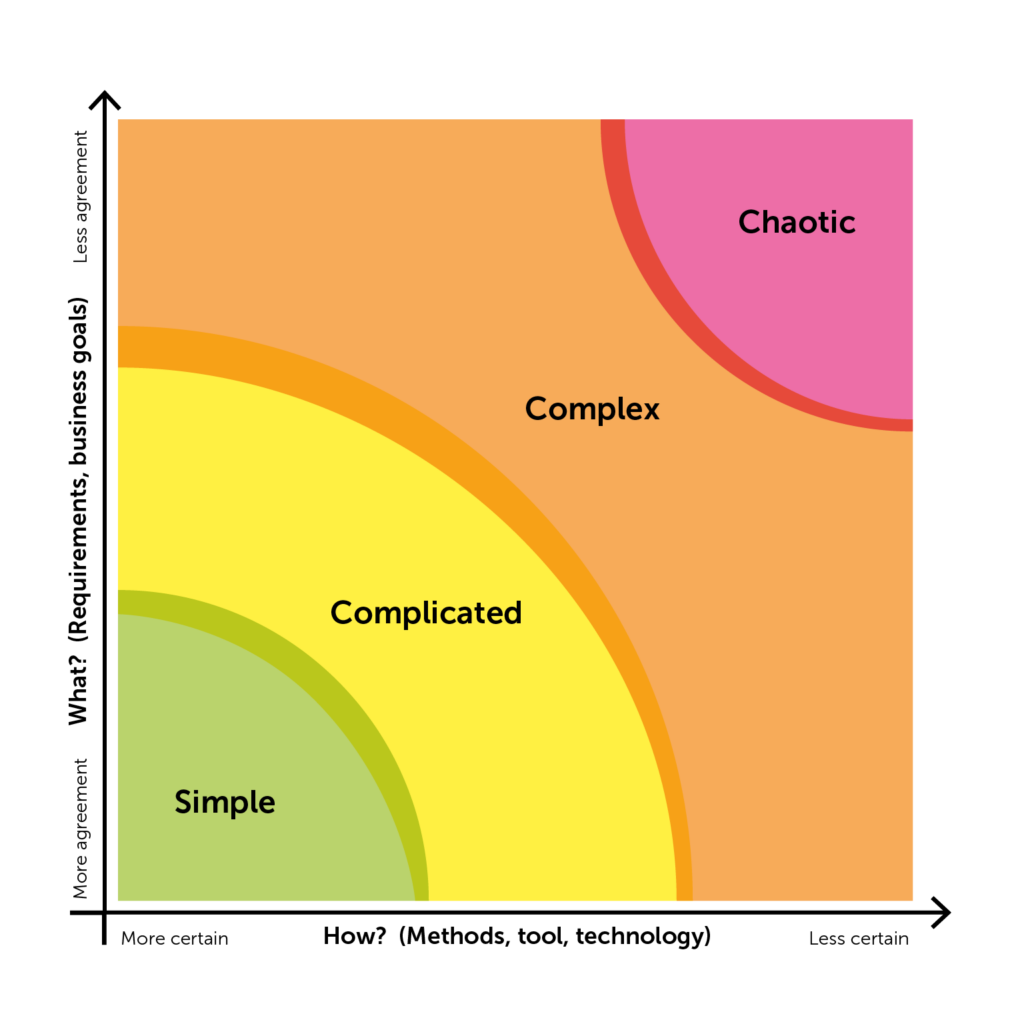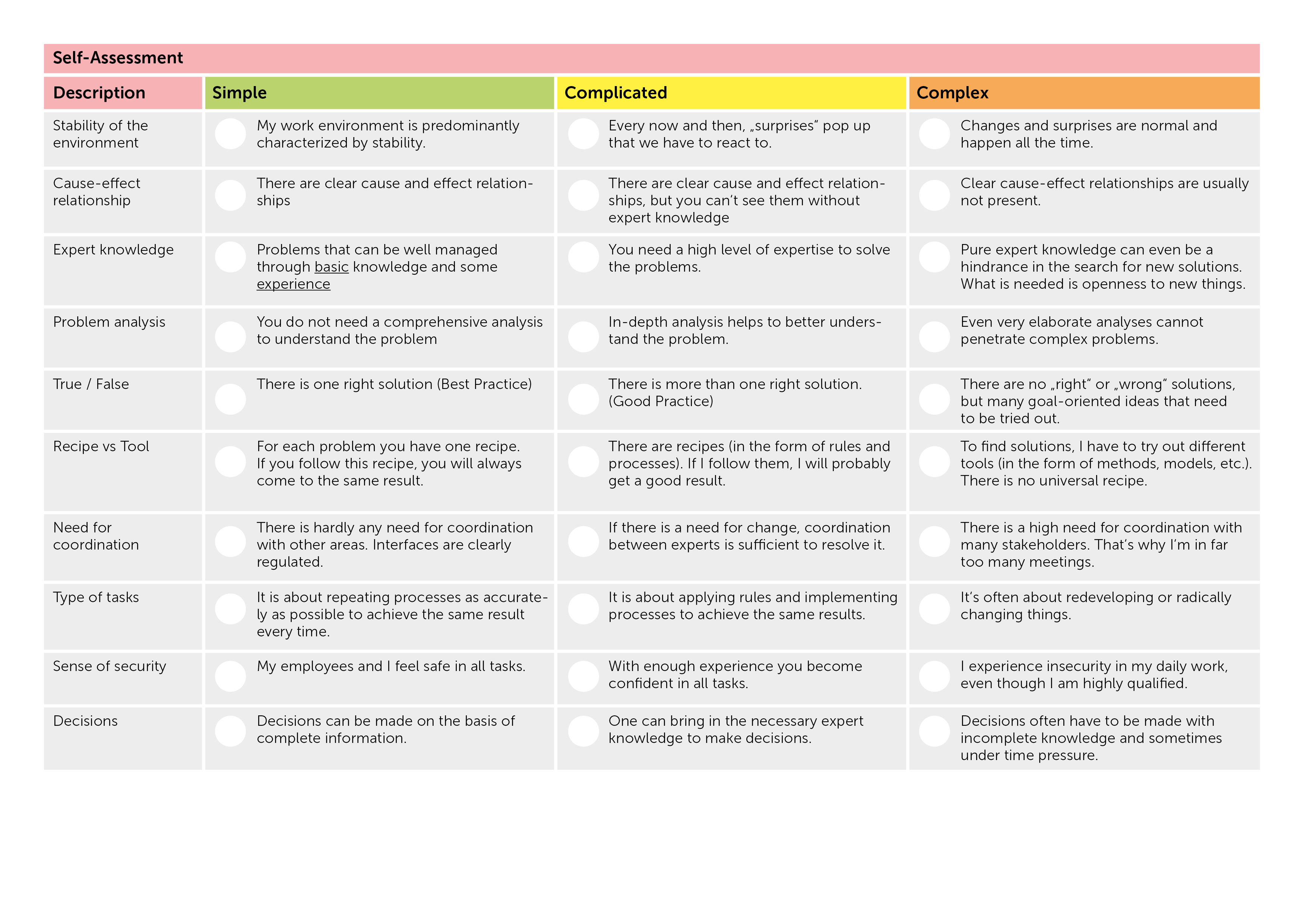Simple, complicated, complex or chaotic situations
It is important to have the ability to distinguish between complicated and complex situations. Both coexist in the modern working world. As soon as you can recognize which situation you are, you can adapt your work and leadership style accordingly, and decide which approach is most effective.

For the sake of completeness, we start with the simple context, knowing that this exists less and less in its pure form in your working world. Simple contexts are characterized by stability and clear cause-and-effect relationships. Often, the right answer is self-evident and undisputed.
In this realm of “known knowns,” decisions are unquestioned because all parties share an understanding. Here, you “sense, categorize, and respond”, which means you assess the facts of the situation, categorize them, and then base their response on established practice.
A lot of times the terms complex and complicated are used interchangeably when, in fact, they represent critically different circumstances.
Complicated contexts, unlike simple ones, may contain multiple right answers, and although there is a clear relationship between cause and effect, not everyone can see it. Because of this, in a complicated context you must sense and analyze the problem before you respond to it. This approach is not easy and often requires a high level of expertise. For example, tax law is complicated, meaning it is highly technical in nature and difficult to understand, but you can break the problem down into discreet parts, consult with an expert (or several), and generally find a solution. It is usually not the best solution, but a good solution. Unlike the simple approach where there is one best practice solution.
Let’s face it, complicated problems can be hard to solve, but they can be tackled with rules and recipes, like the algorithms that place ads in your Twitter feed. They can also be described by proven linear process-flows. In complicated situations the way forward can to be “sold” to others or agreed upon after consultation.
Complex challenges, on the other hand, contain many interdependent elements, some of which may be unknown and may change over time in unpredictable ways. In a complicated context, at least one right answer exists. In a complex context, however, right answers can never be truly identified, because the systemic side effects can never be totally understood. An action or change towards one direction can result in disproportionate and unforeseen outcomes.
As an example, foreign policy and climate change are complex challenges. While there may be no shortage of opinions on these topics, there are no clear solutions. As a result, solutions to complex challenges typically emerge through trial and error and require the willingness, humility, and ability to act even under uncertainty, to learn quickly, and to adapt fast. This requires spaces for co- creation, experimentation and real high-performing teams. The team not only needs expertise and knowledge, but it needs intuition – a quality not often called for in business. The team also needs new ideas, a clear purpose, a personal meaning in what they do and, last but not least, fun while doing it. In complex situations agreement about the way forward has to be co-created.
For leaders this means that in addition to human-centered and appreciative leadership, there are other aspects that need to be included in order to lead well through the complex world.
In chaotic situations the only possible choice is between fight or flight. There is usually no or little room for creativity, strategy or any other kind of conscious and mindful action.
The self-assessment

References
This questionnaire was developed based on various studies and with authors who focus on the topic of working in increasingly complex work situations.
Alan Watkins & Ken Wilber: Wicked & Wise: How to Solve the World’s Toughest Problems, Urbane Publications Limited, 2015.
David J. Snowden and Mary E Boone: A Leader`s Framework for Decision Making, Harvard business review (last checked: 20.04.2023).
Svenja Hofert: Agiler führen, SpringerGabler Verlag, 2018.
And of course:
Based on Ralph D. Stacey. Stacey, Ralph D.: Strategic management and organisational dynamics: the challenge of complexity. Harlow: Prentice Hall, 2002.
DOWNLOADS
Complexity self assessment – Deutsch (PDF for printing)Complexity self assessment – Deutsch (PNG for online collaboration boards)
Complexity self assessment – English (PDF for printing)
Complexity self assessment – English (PNG for online collaboration boards)



